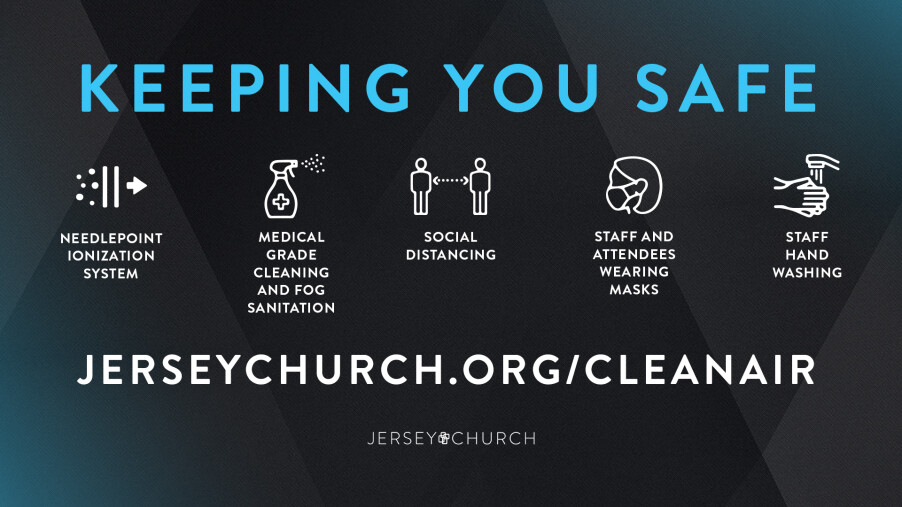Part of our mission of caring for people and connecting them to Christ is doing what we can to make in-person worship experiences as safe as we can.
That’s why we’re excited to feature brand-new air purification systems throughout our campus.
Our newly-installed units will purify the air using needlepoint bipolar ionization. This process has proven effective in reducing and controlling harmful pathogens such as viruses and bacteria.
ABOUT NEEDLEPOINT BIPOLAR IONIZATION
Commercial industries use HVAC units to deliver comfortable temperatures inside of buildings. Heating and cooling units control more than just the temperature. In fact, HVAC units play a significant role in maintaining clean air. Breathable air inside of buildings in an important aspect of maintaining a healthy facility and most importantly, reducing illness. Needlepoint bipolar ionization is a process that is used in heating and cooling systems to provide cleaner breathing air in facilities.
You may be wondering, what exactly is needlepoint bipolar ionization? We clean the air inside of commercial buildings with bipolar ionization. Due to the fact that the air that flows throughout a ventilation system is susceptible to particulate matter, building occupants can be exposed to a number of organisms. Germs are able to circulate throughout a building’s ventilation system. As a result, working within spaces where the air is not purified may lead to serious health implications over the course of time.
Bipolar ionization addresses the need for purified air using a process that targets airborne pollutants. Ionization happens when atoms and molecules are charged by either taking away or adding a bond to create either a positive or negative result. In the case of needlepoint bipolar ionization, energy is generated to absorb and neutralize pollutants. Volatile organic compounds, viruses, bacteria and mold are killed by ionization. Ionization is effective in managing disease control in buildings.
The new process is a technology that uses needlepoint bipolar ionization, which limits the flow of outside air. When outside air enters a building, the ventilation system is susceptible to the growth of microorganisms. Needlepoint bipolar ionization also challenges the growth of mold. Heating and air conditioning units may be top sources for mold due to moisture. The overgrowth of mold in a facility may lead to serious upper respiratory illnesses. Additionally, mold may be responsible for causing damage to certain areas within a facility. Furthermore, mold sometimes results in foul odors which are most uncomfortable to smell while going about daily tasks.
This process is also effective in reducing and controlling harmful pathogens such as viruses and bacteria. Airborne viruses can spread through ventilation systems which may result in costly call-outs and unwanted illness among facility occupants. During outbreaks and throughout flu-seasons, the technology is particularly helpful in controlling the spread of illness.
Viral transmissions are not uncommon in large facilities. Germs such as viruses spread easily through normal activities such as coughing and sneezing. Airflow carries contaminated particles where they can infect other individuals, therefore clean air is a necessity for all commercial and industrial buildings.
Compared to other methods such as UV treatments or steam cleaning, experts find that bipolar ionization more effective. The main issue with viruses is that they may be airborne and also live on surfaces. Bipolar ionization is capable of killing viruses that are spread through droplets from coughing and sneezing as well as the germs that live on surfaces where an infected person has made contact. Surface transmission happens when a non-infected person touches a contaminated surface and subsequently becomes infected thus furthering the spread of illness. In this case needlepoint bipolar ionization is a multi-purpose solution for targeting germs within a building.
Studies conclude that the ionization process has been effective in killing common germs including tuberculosis, various flu strains and the common cold. Furthermore, some commercial facilities house allergens that irritate occupants leading to additional ailments.
Quality air control is essential during peak flu seasons and cycles when diseases run rampant. Facilities can do more to protect occupants with simple but effective tools while maximizing on HVAC applications. HVAC units are instrumental in reducing viral spread.
Just one more step in keeping you safe at Jersey!

